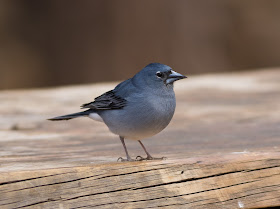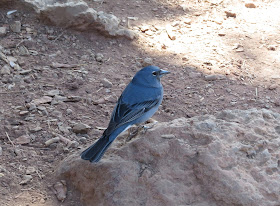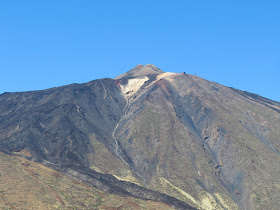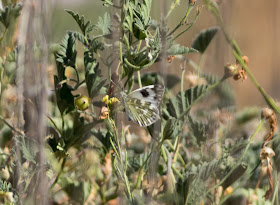Tenerife, the largest and most well-visited location in the Canary Islands archipelago, enjoying both the scorching West-African climate and the well-developed tourism infrastructure of mainland Europe.
A rugged but well-vegetated volcanic landmass consisting of two very different northern and southern climates, this famous holiday destination also boasts a series of specialised island endemic bird species along with an impressive list of interesting flora and fauna. Having visited Fuerteventura the previous autumn for the arid desert loving specialities, the following spring saw us complete the Canary Islands trip double in an effort to catch up with the montane and laurel forest specialists that make Tenerife their home.
Housekeeping
Our trip to Tenerife involved travelling around both the northern and southern sections of the island, incorporating a range of habitats including Mount Teide, Mirador de La Grimona, Barranco de Ruiz, Charco del Viento and Punta de Teno with specific targets of Tenerife Blue Chaffinch, both Laurel and Bolle’s Pigeons, Atlantic Canary, Barbary Falcon, Plain Swift, Barolo Shearwater and Canary Islands Chiffchaff.
7 lifers and 34 species in total were seen during our 5 days in Tenerife (with us missing out on just the Barolo Shearwaters), covering the 17th April – 22nd April 2017.
We hired a car for the duration of the trip from Hertz and flights were direct return from Manchester to Tenerife South Airport. We had no specific route during our journey, and instead travelled sporadically to a number of sites in both the northern and southern sections of the island. From our base in Playa de las Américas we had easy access to both Los Cristianos and Mount Teide, while expeditions to the more lushly vegetated northern half of the island took no longer than an hour and a half. We stayed in one hotel for the duration of the trip – Hotel Olé Tropical Tenerife – part of a resort complex complete with outside pool.
Daily Diary
Landing at Tenerife de Sur on the Monday evening, our late arrival sadly left no time for birding, a calling Canary Islands Chiffchaff outside the hotel the only indications of the upcoming endemic specialities that lay in wait for us.
A rugged but well-vegetated volcanic landmass consisting of two very different northern and southern climates, this famous holiday destination also boasts a series of specialised island endemic bird species along with an impressive list of interesting flora and fauna. Having visited Fuerteventura the previous autumn for the arid desert loving specialities, the following spring saw us complete the Canary Islands trip double in an effort to catch up with the montane and laurel forest specialists that make Tenerife their home.
Housekeeping
Our trip to Tenerife involved travelling around both the northern and southern sections of the island, incorporating a range of habitats including Mount Teide, Mirador de La Grimona, Barranco de Ruiz, Charco del Viento and Punta de Teno with specific targets of Tenerife Blue Chaffinch, both Laurel and Bolle’s Pigeons, Atlantic Canary, Barbary Falcon, Plain Swift, Barolo Shearwater and Canary Islands Chiffchaff.
7 lifers and 34 species in total were seen during our 5 days in Tenerife (with us missing out on just the Barolo Shearwaters), covering the 17th April – 22nd April 2017.
 |
| Tenerife Blue Chaffinch |
 |
| The panoramic view from our balcony at Hotel Olé Tropical Tenerife |
Daily Diary
With blue skies and bright sunshine dawning the next morning, we made a relatively early start getting to our first and main birding site of the trip – the picnic site at Las Lajas on the outskirts of the impressive Mount Teide. Renowned for its showy and approachable population of the endemic Tenerife Blue Chaffinch (Gran Canaria Blue Chaffinch has recently been split) Las Lajas is a must for any visiting birders taking a trip to Tenerife.
 |
| The famous Las Lajas picnic site |
 |
| Plain Swift - our first of many |
Originally concerned they may have been hard to come across during our trip, we needn’t have worried as these delightful swifts were dotted across the island in relatively good numbers, some even gracing the skies outside out hotel with their aerial acrobatics.
 |
| The picnic table clearings of Las Lajas that the Blue Chaffinches call home |
 |
| Canary Islands Kinglet.... aka just a Goldcrest nowadays |
Thankfully, a movement in the tall pines and around one of the picnic tables caught our attention, and we were soon admiring our first Tenerife Blue Chaffinch – a handsome male taking advantage of the small scraps and crumbs left behind by the previous day’s picnickers, soon joined by a slightly drabber female.
Hopping around the wooden tables, the delicate powder blues and slate grey in the feathers appeared silky smooth in the light, and we watched on in awe as up to four male birds proceeded to parade around us mere feet away hoovering up the titbits – an incredible experience.
 |
| Tenerife Blue Chaffinch! What a stunner |
Seemingly quite used to visitors and clearly habituated to human presence due to the sheer volume of holidaymakers stopping for a lunch break or snack at Las Lajas, it was refreshingly easy to get some point blank images of this spectacular endemic – no obstructing branches or leaves making for a welcome change.
 |
| The female - much drabber in colouration |
 |
| The picnic tables the Tenerife Blue Chaffinches favour |
 |
| It was surreal to see them so close on the picnic tables - like House Sparrows behave back home |
 |
| Great Spotted Woodpecker - the Tenerife subspecies Dendrocopos major canariensis |
 |
| African Blue Tit - the Tenerife susbpecies Cyanistes teneriffae teneriffae |
 |
| Raven - Corvus corax canariensis - the Canary Islands subspecies |
Taking a wander a bit further down the track resulted in our first Canary Blue butterfly sunning itself on a wall next to a small patch of delicate purple flowers, while several larger yellow butterflies remained unidentifiable as they powered over the taller shrubs.
Our first West Canaries Lizards also made an appearance, emerging tentatively from their burrows just long enough to capture a quick photo before they scurried back to safety.
 |
| Canary Blue Butterfly...not looking particularly blue! |
 |
| Male West Canaries Lizard peeking out of the rocks |
 |
| The females lack the blue colouration of the males |
 |
| Atlantic Canary - not in a cage! |
Nowhere near as approachable as the Tenerife Blue Chaffinches, we found it difficult to get close, the flock flying off to a different area of the picnic site if we got too near, but we eventually secured good views as one particular individual hopped up on to one of the tables to feed.
After a quick break for lunch (hand feeding BBQ Pringles to a Tenerife Blue Chaffinch at my feet was not something I expected to do during the trip!) we were slightly concerned to find that the car next to ours had been broken in to, the back windows smashed by a large boulder now lying on the back seat and all the valuables inside taken by thieves, much to the distress of the German tourists who had hired it. Luckily we’d not left anything on display, but most definitely a word of warning for anyone visiting – don’t leave anything on show and certainly don’t leave any scopes or cameras in the car.
 |
| The car park at Las Lajas |
 |
| The impressive Mount Teide |
 |
| Canary Red Admiral - very similar to our British Red Admiral but differs by being a darker shade of red and by having black patches interspersed among the red upper-wing colour blocks |
 |
| The Canary Islands Chiffchaff roadside |
 |
| Canary Islands Chiffchaff |
 |
| Bath White - another new butterfly for our list |
























































No comments:
Post a Comment